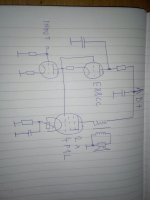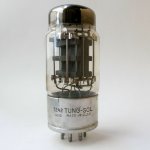6A3 Summer, I get your point. You test the amplifier way beyond real working conditions?
Which is absolutely fine of course.
Really, I dont know. For a hobbyist who doesnt have expensive equipment for these measurenments.
If amplifier oscillates or distorts you can see on an oscilloscope and resistor, of course. And if Im interested in real life performance, for me simplest is to do A/B listening test. Make some black box with a switch, where I would have the two bias options, two coupling capacitors or whatever Im comparing and simply guess which is better...
I also agree that you must use what you have.
A year back I did something like this:

Which is absolutely fine of course.
Really, I dont know. For a hobbyist who doesnt have expensive equipment for these measurenments.
If amplifier oscillates or distorts you can see on an oscilloscope and resistor, of course. And if Im interested in real life performance, for me simplest is to do A/B listening test. Make some black box with a switch, where I would have the two bias options, two coupling capacitors or whatever Im comparing and simply guess which is better...
I also agree that you must use what you have.
A year back I did something like this:

MikyK,
Even low cost scopes of today have FFTs, to do spectral measurements.
You can see the fundamental, harmonics, and oscillations.
I use a Denon Audio Test CD and put that CD into a CD player for many of my tests.
Frequency response, harmonic distortion, intermodulation distortion.
It can also do a quick test of the speaker impedance versus frequency as the varying impedanc loads the amplifier (I use the impulse test signal from the Denon CD).
After I test as much as my equipment allows, then I connect a CD player, loudspeaker, and listen to many types of music. Then I try another loudspeaker, and listen again with many types of music, etc.
Sometimes an amplifier does not really sound very good. It either gets modified, or it gets torn down, and a new amp is built on the chassis.
Even low cost scopes of today have FFTs, to do spectral measurements.
You can see the fundamental, harmonics, and oscillations.
I use a Denon Audio Test CD and put that CD into a CD player for many of my tests.
Frequency response, harmonic distortion, intermodulation distortion.
It can also do a quick test of the speaker impedance versus frequency as the varying impedanc loads the amplifier (I use the impulse test signal from the Denon CD).
After I test as much as my equipment allows, then I connect a CD player, loudspeaker, and listen to many types of music. Then I try another loudspeaker, and listen again with many types of music, etc.
Sometimes an amplifier does not really sound very good. It either gets modified, or it gets torn down, and a new amp is built on the chassis.
Last edited:
Thanks, I think it can not get better than what you´ve just described in home conditions.
What about to use Ale Moglia´s gyrator on E88CC anode and LM317 on the 2A3 (or 2x 4P1L) cathode to maintain stable current - Alex Kitic´s idea?
Or go the power supply idea -use symmetrical power supply for the driver stage so in the 2a3 cathode will be only small current monitoring resistor?
What are your opinions about this?
What about to use Ale Moglia´s gyrator on E88CC anode and LM317 on the 2A3 (or 2x 4P1L) cathode to maintain stable current - Alex Kitic´s idea?
Or go the power supply idea -use symmetrical power supply for the driver stage so in the 2a3 cathode will be only small current monitoring resistor?
What are your opinions about this?
What about to use Ale Moglia´s gyrator on E88CC anode and LM317 on the 2A3 (or 2x 4P1L) cathode to maintain stable current - Alex Kitic´s idea?
Or go the power supply idea -use symmetrical power supply for the driver stage so in the 2a3 cathode will be only small current monitoring resistor?
What are your opinions about this?
I think Ale's gyrator and maybe source follower too is a good idea but it's not direct coupled - that's more complicated. Certainly nothing I've tried personally, though I've used the gyrator.
Andy, I thought of using only the gyrator which would be DC coupled to the 2A3 grid, so no complications. The cathode of 2A3 would have to be elevated with a resistor as with other dc coupled amps. or maybe some more fancy technology.
Apparently he doesn't consider B+ capacitors 'in the signal path'.There is a half schematic in the owner’s manual.
Unfortunately, this has nothing to do with Diy. Without design detail, it is just another sales pitch among many that we are all so familiar with. Happy customer raves notwithstanding. How can one be unhappy if you paid thousands for it? This belongs to Audio Asylum fora were inmates meaninglessly juggle with brand names.
I am not selling anything. I have nothing to do with the guy that makes these. I listened to them, I was impressed and thought they were something special. And actually it is DIY for the guy who built them. He builds them in his house.
But even if it isn't a diy thing, the only real off topic post was yours complaining about it. just sayin' I didn't think mentioning an amplifier I liked was off topic.
Well I am happy to say that this is no longer the finest amp (of its type) that I have ever listened to. I actually prefer mine. 300B SET with all lundahl iron, Duelund coupling caps, Intact audio TVCs and Tent labs heater boards. Power supply uses Soviet PIO and teflon caps with a choke. Paired up with my recently aquired LaScalas and new xovers you can close your eyes and think you are in a jazz club with dishes rattling in the kitchen and smoke filling the air. Mine has a live presence that the 2A3 amp lacked and the bottom end sounds more real in my system than it did in his. I am a biased observer of course but I call it like I hear it.
I actually prefer mine. 300B SET with all lundahl iron, Duelund coupling caps, Intact audio TVCs and Tent labs heater boards. Power supply uses Soviet PIO and teflon caps with a choke. Paired up with my recently aquired LaScalas and new xovers you can close your eyes and think you are in a jazz club with dishes rattling in the kitchen and smoke filling the air.
As they say in Yorkshire "that'll do!"
Mind you don't fall asleep in the bass solo.....
Need Bass? Get a bigger triode:
And use a P-P OT with a current source on one side for DC balance if you still want SET mode. (no air gap to get in the way, and way reduced OT magnetizing current.) Use an UnSet drive scheme to get quality triode curves. (the regulator type tubes generally have poor triode curves without the fix, high 2nd harmonic.)
And use a P-P OT with a current source on one side for DC balance if you still want SET mode. (no air gap to get in the way, and way reduced OT magnetizing current.) Use an UnSet drive scheme to get quality triode curves. (the regulator type tubes generally have poor triode curves without the fix, high 2nd harmonic.)
Attachments
Last edited:
Since I can't hear it from here, how about a schematic? And some objective measurements. Good engineering will speak for itself.
Not to be unkind, however I think this forum requires a little more than subjective remarks about amplifiers not seen or heard on the other side of the world.
What would you have him measure? By typical engineering standards these amps probably measure like crap. I'd guess 3%-5% THD typically.
I'll stick with my VFETs.
Not to stomp in the chili but I would not discount the possibility that the OB speakers had a lot to do with the sound stage.
- Home
- Amplifiers
- Tubes / Valves
- Best amplifier I have ever listened to
